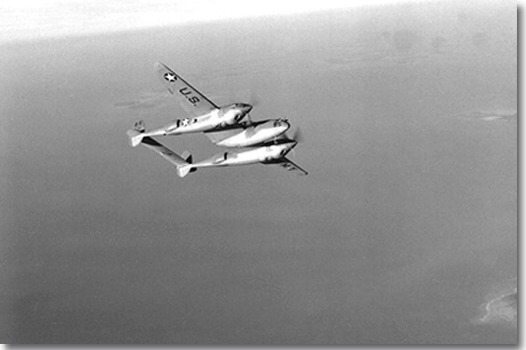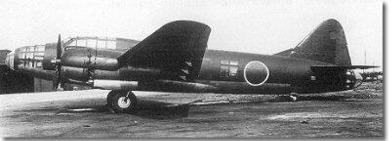|
Admiral Yamomoto on board his Flagship
 | Admiral Isoroku, as CinC of the Imperial Japanese Navy, was responsible for the devastating and devious attack on Pearl Harbor on the 7th of December 1941.
His career stretched back to the victorious campaign of the Russo / Japanese war of 1904.
He had spent time in the Unites States of America, and was believed to like Americans, and he certainly understood the capability of the US armed forces and the country's capacity to wage war.
In 1943, he had been one of the driving forces behind Japan's conquests and advances in the Pacific Campaign, but with the Battles of the Coral Sea and Midway in April and May of 1942, the tide was slowly turning against Japan. US Marines had clung on to Guadalcanal, and turned that landing into victory.
US Naval intelligence, having cracked the Japanese Military Code, picked up a vital message on the 14th. of April 1943, they learned that "Yamamoto was flying to Bouganville, an island off New Guinea, in a Betty, twin engined bomber on the 18th. of April. He would be escorted by 6 Zero fighters, and was due to arrive at 0800 (8 AM) and leave by boat for the Shortland Islands at 0840. (8.40 AM)
Yamamoto's mission was to fly the flag amongst some of Japan's outlying military posts, trying to boost morale against the American and Allied offensives in that area of the Pacific.
The US Navy's C in C Admiral Nimitz, was appraised of Yamamoto's intended trip. With President Roosevelt's and the Secretary of the Navy Knox's thumbs up, it was decided to go after Yamamoto and kill him.
Twin engined, twin tailed Lightning P- 38 US fighter
 |
Major John Mitchell of the 13th Air Force's 339 Squadron was given this job, his squadron of twin engined and twin tailed Lightning, P-38 fighters, based at Guadalcanal, were the only aircraft in this arena capable of making the 425 mile each way haul to Bouganville. These fighters each carried a 20mm cannon, and 4 by 50 calibre machine guns, and when fitted with an extra 300 gas tank to back up the existing 165 gallon tank, they would carry sufficent gasoline for the proposed return trip from Guadalcanal to Bouganville.
Mitchell now selected another 17 pilots to join him, from these, he chose 4, Lt. Tom Lamphier as leader, Lt. Rex Barber, Lt. Joe Moore , and Lt. Jim McLanahan, he named them the "KILLER SECTION."
The remaining 14, P-38's were to cover this section, and deal with the escort fighters, and any other local aircraft that may challenge them.
It was planned to wave hop all the way to Bouganville, and to maintain radio silence.
After the group took off early on the morning of the 18th. of April, both Mc Lanahan and Moore had aircraft problems, and their planes dropped out of this mission. They were replaced by Lt's Besby Holmes and Ray Hine.
Some estimates made at base, suggested that up to 80 aircraft could swarm up from the Bouganville airstrip to cover Yamamoto's arrival over the town.
Mitsubishi Betty Twin engined Bomber
 | The American force's arrival over Bouganville had been timed to perfection, probably more good luck than good planning, they sighted the Japanese group, but it contained two Betty bombers, and not just one as expected. Thus, to ensure that the Japanese Admiral was disposed of, both bombers would have to be destroyed. Both Lamphier and Barber were later to claim they were the one to shoot down the Betty with Admiral Yamamoto onboard.
To this end, it matters little, who actually became "The executioner."
On the attacking signal being given, Holmes could not rid himself of the extra fuel tanks, he left the area covered by his wingman Hine, to try and shake these tanks free into the ocean. Barber and Lamphier were left to get on with the main task, and deal with the two Betty Bombers, Barber shot down one Bomber which crashed into the jungle, he was attacked by 2 Zero fighters which were driven off by the P 38's providing cover. The second Betty skimming close to the ocean was attacked by both Holmes and Hine, but now, Barber flew closely behind this Betty and blasted it out of the sky, he now shot down an attacking Zero, then headed for Guadalcanal.
But Lamphier had a different story to tell, he claimed to have shot down a Zero, then chased a Betty flying over the treetops, he blasted away, watching a wing fall off, before the Bomber crashed into the jungle. He then took off for home. Only three of the Killer Section survived, as Hine did not make it back.
Not wanting to alert the Japanese to the fact their code was broken, this whole episode was kept secret, the Japanese waited some time, then merely reported that Admiral Yamamoto had died in action.
The last serving Zero pilot alive on the 13th of June, in 1975 made a statement of what he recalled of that fateful morning's action, his name, Kenji Yanagiya. He says there were two Bombers, with Admiral Yamamoto in the lead one, and it was shot down, crashing over the jungle, he makes no reference about a wing falling off the Bomber, or of a Zero being shot down.
In 1984, the leader who headed the rescue team into the jungle stated that Yamamoto was dead aboard the Betty Bomber, and that he saw no guns in this plane. This seems to point to the likelihood that Lamphier shot down the second Betty in line, as he claimed that he was fired upon by a tail gunner.
Mitchell always thought that it was Barber who had actually killed Yamamoto.
Conclusion
Who ever was finally responsible does not really matter, especially at this distance in time from the event.
This operation was indeed a remarkable and brave achievement by Major John Mitchell and his P-38 fliers.
Pearl Harbor had been partly avenged by this "Execution of Admiral Yamamoto."
|